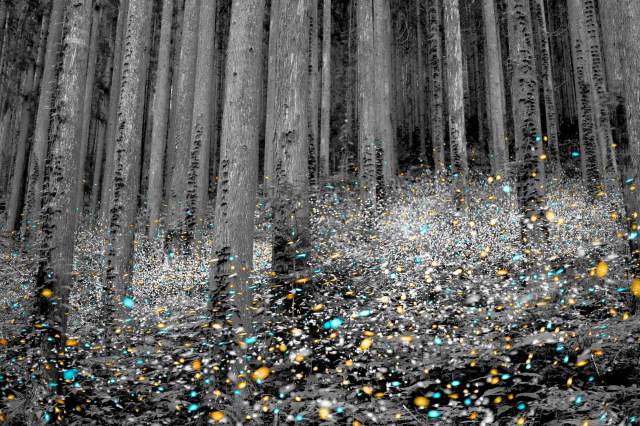
They’re Not Actually Flies – They’re Beetles
More than 2,000 species of fireflies haunt damp woodlands, forests, wetlands, suburbs, and city parks on every continent except Antarctica. About 160 species live in the U.S. and Canada, and their populations overlap so much that several species might be seen in one backyard at the same time.
Though fireflies are quite diverse in their appearance and behavior, they all belong to the Lampyridae family within the order Coleoptera, which consists of beetles and weevils. Anatomically, fireflies and other beetles have hardened wing covers, called elytra, that differentiate them from flies and other types of insects.

Whether You Call Them “Fireflies” or “Lightning Bugs” Depends on Where You Live
If you live in the American West or New England, you likely know the members of Lampyridae as “fireflies.” Those in the Midwest and South, however, probably think of them as “lightning bugs.” Jason Keeler, an assistant professor of Earth and atmospheric sciences at Central Michigan University, tweeted a possible explanation for the geographic choices. He noted that the “firefly” regions experience the United States’ highest wildfire activity (in the West, at least), while the “lightning bug” areas have the most lightning strikes.
According to the Oxford English Dictionary, since the 16th century, fireflies have also been called fireworms, salamander flies, firebugs, glow flies, lightning beetles, and meadow flies.

Fireflies’ Light Comes From a Chemical Reaction
Not all fireflies produce light, but the ones that do give off their glow thanks to a biochemical reaction. Their light is produced when an enzyme, luciferase, interacts with a chemical called luciferin, oxygen, and ATP — a protein that facilitates energy production. Fireflies likely control their blinking patterns by regulating the amount of oxygen feeding the chemical reaction.
Luciferin and luciferase interact so well together that scientists use them in medical applications, including immunological and gene expression assays, drug tests, and cancer research, according to a 2019 article in the journal BioScience. In one example, researchers have injected luciferase into cancer cells to see whether immunotherapies are killing them off.
More Interesting Reads

Their Bioluminescence Is Incredibly Efficient
Entomologists call fireflies’ illumination “cold light” because 100% of the energy used to produce it is turned into actual light, and none is lost as other forms of energy. By comparison, a traditional incandescent light bulb converts 20% of its electricity into light and loses 80% as heat. Even modern LED light bulbs aren’t as efficient as fireflies.

Fireflies Communicate by Flashing in Unique Patterns
Each firefly species flashes with its own Morse code-like sequence, which members of the species use to signal potential mates. In North America, male fireflies will typically fly back and forth across a small area, blinking rhythmically, while the females perch in grass or shrubs and respond to the males with their own light. Eventually, the male will make his way over to the female by following her glow. Non-bioluminescent fireflies use pheromones instead of light to attract mates.
A few species even synchronize their light show. Among Photinus carolinus, a species native to the southern Appalachians, the males blink in unison during their mating season, creating a major tourist event in Great Smoky Mountains National Park every June. A species seen in South Carolina’s Congaree National Park, Photuris frontalis, synchronizes intermittently in flight.

Fireflies Spend Most of Their Lives Underground
A firefly begins its existence as a faintly glowing egg in moist soil or leaf litter. About three weeks after the egg is laid, the firefly larva emerges and remains in its damp habitat, gobbling up worms, slugs, and other invertebrates. It eats and grows for two years, and then enters the pupal stage of its development. Over the next three weeks, the pupa metamorphoses into an adult firefly (similar to a caterpillar turning into a butterfly). Only then does the firefly finally emerge from its underground habitat and fly free.

Fireflies Are Sensitive to Light Pollution
Artificial light affects organisms that are active during twilight or at night. According to a 2018 study, 47% of the U.S. and 88% of Europe experience light pollution from artificial sources at night, which may account for the decline in many insect populations, including fireflies. LED signage, municipal street lights, vehicle headlights, and even cellphone screens have the potential to obscure fireflies’ flashing signals, temporarily blinding or disorienting them, or limiting their courtship. More research is needed to understand how fireflies are coping with our modern world.











